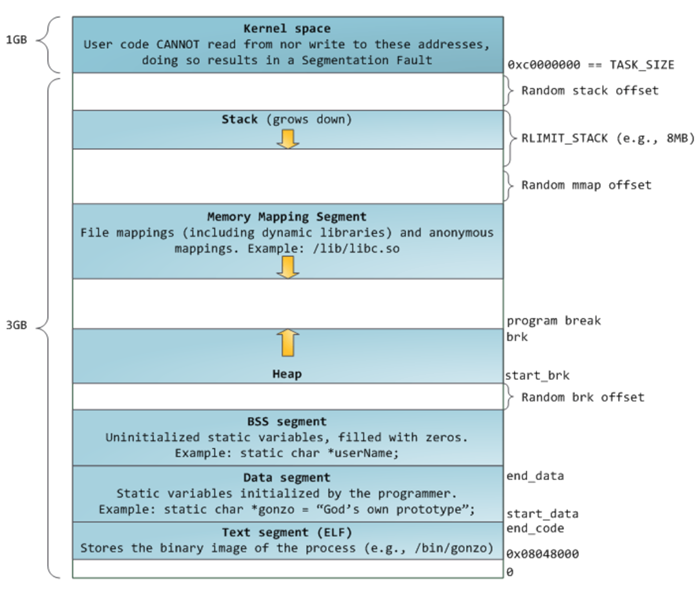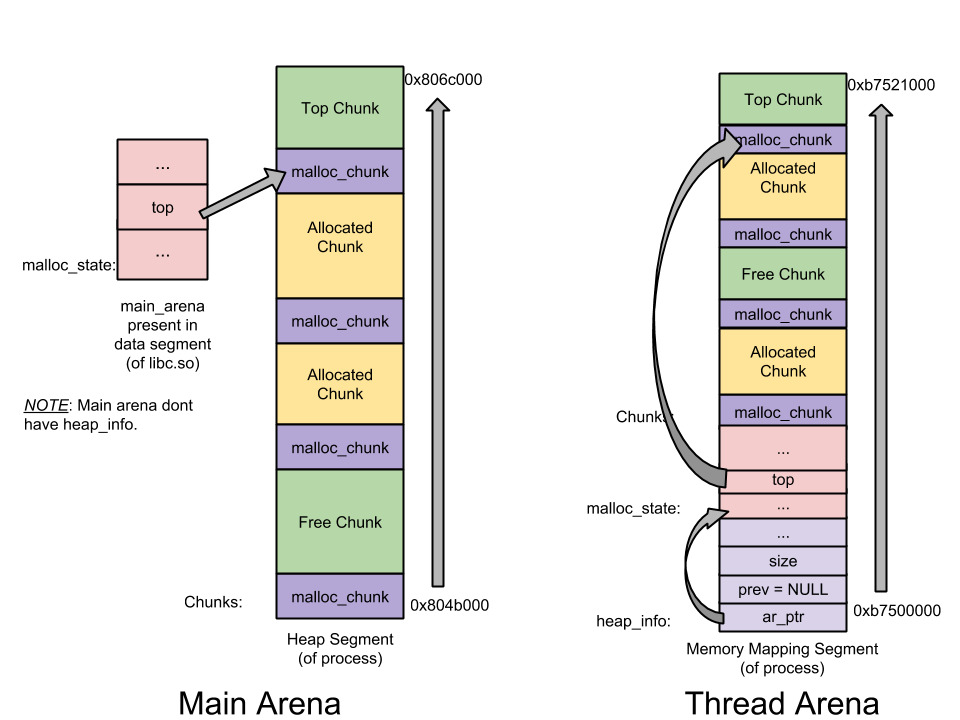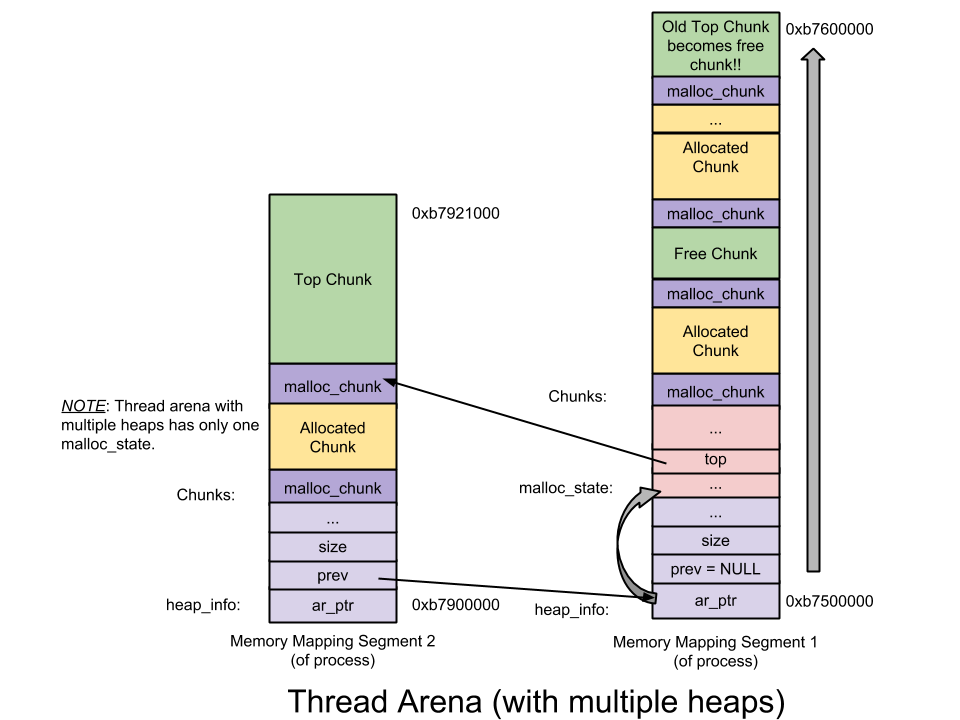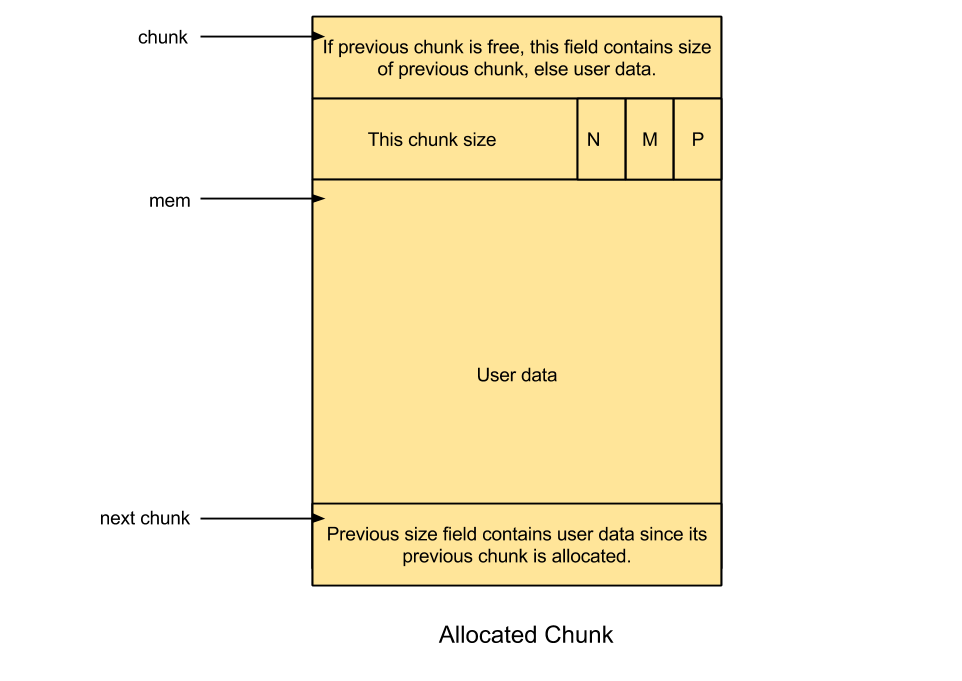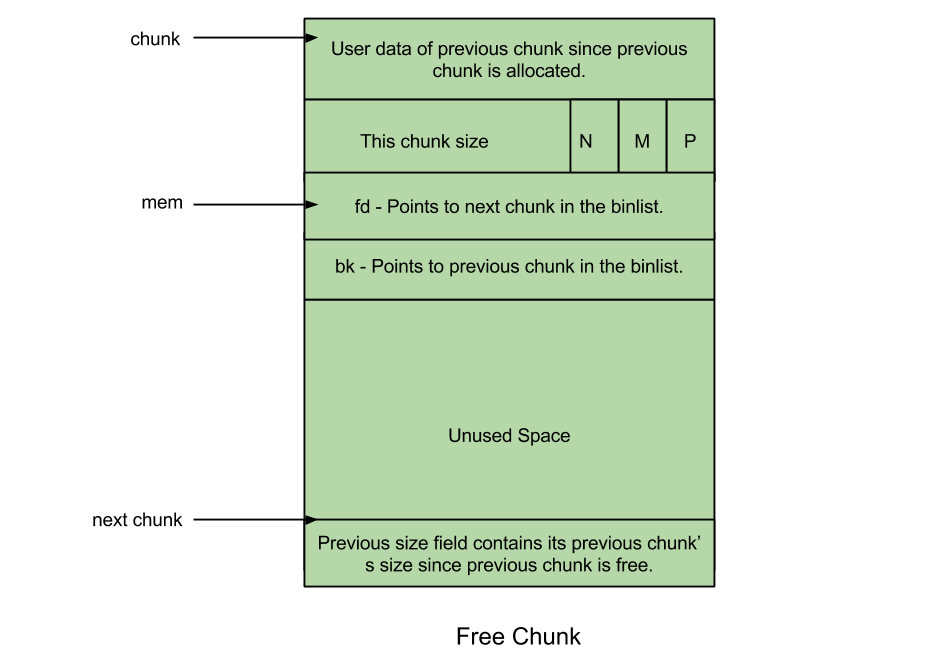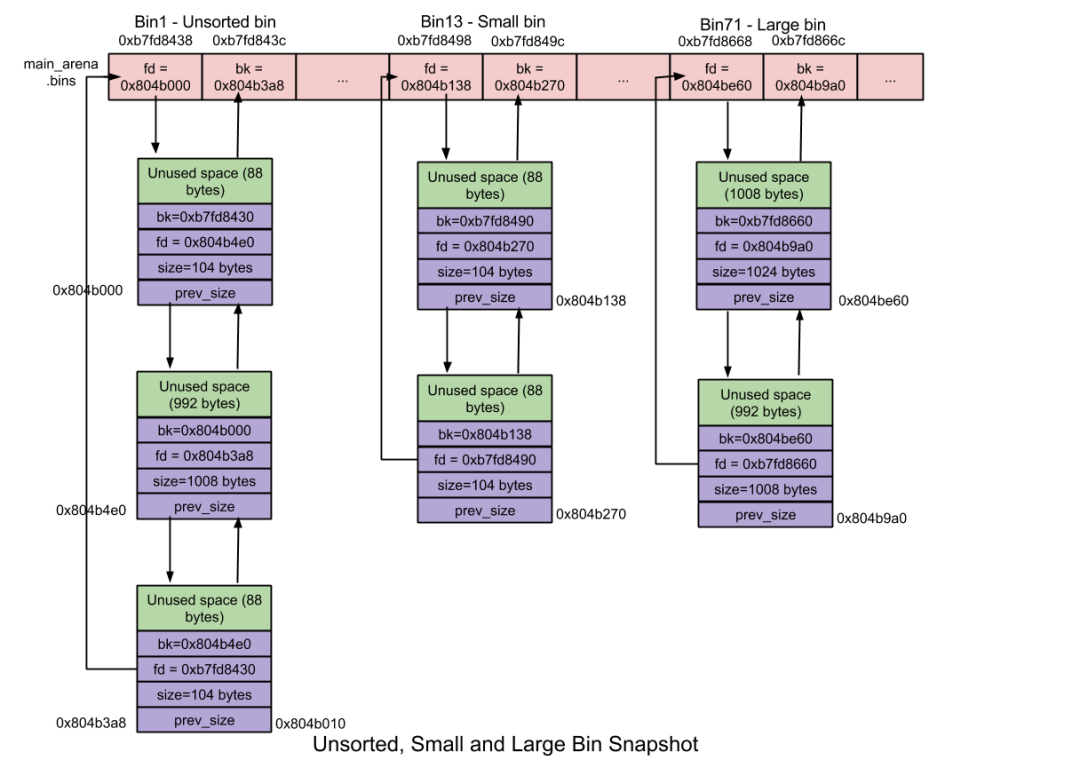深入理解glibc malloc:内存分配器实现原理
Understanding glibc malloc
日志:
- [2019-10-10] 经评论 @kwdecsdn 提醒,新增对「Unsorted Bin 中的 chunks 何时移至 small/large chunk 中」的补充解释。
- [2019-02-06] 勘误与代码着色优化;
- [2018-05-22] 内容优化与排版优化;
- [2017-03-17] 优化排版.
文章目录
- Understanding glibc malloc
- 5.1. Fast Bin
- 5.2. Unsorted Bin
- 5.3. Small Bin
- 5.4. Large Bin
- 5.5. Top Chunk
- 5.6. Last Remainder Chunk
- 4.1. Allocated chunk
- 4.2. Free chunk
- 3.1. Arena 的数量
- 3.2. Multiple Arena
- 3.3. Multiple Heaps
- 2.1. 案例代码
- 2.2. 案例输出
- 2.2.1. 在主线程 malloc 之前
- 2.2.2. 在主线程 malloc 之后
- 2.2.3. 在主线程 free 之后
- 2.2.4. 在 thread1 malloc 之前
- 2.2.5. 在 thread1 malloc 之后
- 2.2.6. 在 thread1 free 之后
- 前言
- 1. 申请堆的系统调用
- 2. 多线程支持
- 3. Arena
- 4. Chunk
- 5. Bins
前言
堆内存(Heap Memory)是一个很有意思的领域。你可能和我一样,也困惑于下述问题很久了:
- 如何从内核申请堆内存?
- 谁管理它?内核、库函数,还是应用本身?
- 内存管理效率怎么这么高?!
- 堆内存的管理效率可以进一步提高吗?
最近,我终于有时间去深入了解这些问题。下面就让我来谈谈我的调研成果。
开源社区公开了很多现成的内存分配器(Memory Allocators,以下简称为分配器):
- dlmalloc – 第一个被广泛使用的通用动态内存分配器;
- ptmalloc2 – glibc 内置分配器的原型;
- jemalloc – FreeBSD & Firefox 所用分配器;
- tcmalloc – Google 贡献的分配器;
- libumem – Solaris 所用分配器;
- …
每一种分配器都宣称自己快(fast)、可拓展(scalable)、效率高(memory efficient)!但是并非所有的分配器都适用于我们的应用。内存吞吐量大(memory hungry)的应用程序,其性能很大程度上取决于分配器的性能。
在这篇文章中,我只谈「glibc malloc」分配器。为了方便大家理解「glibc malloc」,我会联系最新的源代码。
历史:ptmalloc2 基于 dlmalloc 开发,其引入了多线程支持,于 2006 年发布。发布之后,ptmalloc2 整合进了 glibc 源码,此后其所有修改都直接提交到了 glibc malloc 里。因此,ptmalloc2 的源码和 glibc malloc 的源码有很多不一致的地方。(译者注:1996 年出现的 dlmalloc 只有一个主分配区,该分配区为所有线程所争用,1997 年发布的 ptmalloc 在 dlmalloc 的基础上引入了非主分配区的概念。)
1 . 申请堆的系统调用
我在之前的文章中提到过,malloc 内部通过 brk 或 mmap 系统调用向内核申请堆区。
译者注:在内存管理领域,我们一般用「堆」指代用于分配动态内存的虚拟地址空间,而用「栈」指代用于分配静态内存的虚拟地址空间。具体到虚拟内存布局(Memory Layout),堆维护在通过
brk系统调用申请的「Heap」及通过mmap系统调用申请的「Memory Mapping Segment」中;而栈维护在通过汇编栈指令动态调整的「Stack」中。在 Glibc 里,「Heap」用于分配较小的内存及主线程使用的内存。下图为 Linux 内核 v2.6.7 之后,32 位模式下的虚拟内存布局方式。
2 . 多线程支持
Linux 的早期版本采用 dlmalloc 作为它的默认分配器,但是因为 ptmalloc2 提供了多线程支持,所以 后来 Linux 就转而采用 ptmalloc2 了。多线程支持可以提升分配器的性能,进而间接提升应用的性能。
在 dlmalloc 中,当两个线程同时 malloc 时,只有一个线程能够访问临界区(critical section)——这是因为所有线程共享用以缓存已释放内存的「空闲列表数据结构」(freelist data structure),所以使用 dlmalloc 的多线程应用会在 malloc 上耗费过多时间,从而导致整个应用性能的下降。
在 ptmalloc2 中,当两个线程同时调用 malloc 时,内存均会得以立即分配——每个线程都维护着单独的堆,各个堆被独立的空闲列表数据结构管理,因此各个线程可以并发地从空闲列表数据结构中申请内存。这种为每个线程维护独立堆与空闲列表数据结构的行为就「per thread arena」。
2.1. 案例代码
/* Per thread arena example. */
#include <stdio.h>
#include <stdlib.h>
#include <pthread.h>
#include <unistd.h>
#include <sys/types.h>
void* threadFunc(void* arg) {
printf("Before malloc in thread 1\n");
getchar();
char* addr = (char*) malloc(1000);
printf("After malloc and before free in thread 1\n");
getchar();
free(addr);
printf("After free in thread 1\n");
getchar();
}
int main() {
pthread_t t1;
void* s;
int ret;
char* addr;
printf("Welcome to per thread arena example::%d\n",getpid());
printf("Before malloc in main thread\n");
getchar();
addr = (char*) malloc(1000);
printf("After malloc and before free in main thread\n");
getchar();
free(addr);
printf("After free in main thread\n");
getchar();
ret = pthread_create(&t1, NULL, threadFunc, NULL);
if(ret)
{
printf("Thread creation error\n");
return -1;
}
ret = pthread_join(t1, &s);
if(ret)
{
printf("Thread join error\n");
return -1;
}
return 0;
}2.2. 案例输出
2.2.1. 在主线程 malloc 之前
从如下的输出结果中我们可以看到,这里还没有堆段也没有每个线程的栈,因为 thread1 还没有创建!
sploitfun@sploitfun-VirtualBox:~/ptmalloc.ppt/mthread$ ./mthread
Welcome to per thread arena example::6501
Before malloc in main thread
...
sploitfun@sploitfun-VirtualBox:~/ptmalloc.ppt/mthread$ cat /proc/6501/maps
08048000-08049000 r-xp 00000000 08:01 539625 /home/sploitfun/ptmalloc.ppt/mthread/mthread
08049000-0804a000 r--p 00000000 08:01 539625 /home/sploitfun/ptmalloc.ppt/mthread/mthread
0804a000-0804b000 rw-p 00001000 08:01 539625 /home/sploitfun/ptmalloc.ppt/mthread/mthread
b7e05000-b7e07000 rw-p 00000000 00:00 0
...
sploitfun@sploitfun-VirtualBox:~/ptmalloc.ppt/mthread$
2.2.2. 在主线程 malloc 之后
从如下的输出结果中我们可以看到,堆段已经产生,并且其地址区间正好在数据段(0x0804b000 - 0x0806c000)上面,这表明堆内存是移动「Program Break」的位置产生的(也即通过 brk 中断)。此外,请注意,尽管用户只申请了 1000 字节的内存,但是实际产生了 132KB 的堆。这个连续的堆区域被称为「arena」。因为这个 arena 是被主线程建立的,因此其被称为「main arena」。接下来的申请会继续分配这个 arena 的 132KB 中剩余的部分。当分配完毕时,它可以通过继续移动 Program Break 的位置扩容。扩容后,「top chunk」的大小也随之调整,以将这块新增的空间圈进去;相应地,arena 也可以在 top chunk 过大时缩小。
注意:top chunk 是一个 arena 位于最顶层的 chunk。有关 top chunk 的更多信息详见后续章节「top chunk」部分。
sploitfun@sploitfun-VirtualBox:~/ptmalloc.ppt/mthread$ ./mthread
Welcome to per thread arena example::6501
Before malloc in main thread
After malloc and before free in main thread
...
sploitfun@sploitfun-VirtualBox:~/lsploits/hof/ptmalloc.ppt/mthread$ cat /proc/6501/maps
08048000-08049000 r-xp 00000000 08:01 539625 /home/sploitfun/ptmalloc.ppt/mthread/mthread
08049000-0804a000 r--p 00000000 08:01 539625 /home/sploitfun/ptmalloc.ppt/mthread/mthread
0804a000-0804b000 rw-p 00001000 08:01 539625 /home/sploitfun/ptmalloc.ppt/mthread/mthread
0804b000-0806c000 rw-p 00000000 00:00 0 [heap]
b7e05000-b7e07000 rw-p 00000000 00:00 0
...
sploitfun@sploitfun-VirtualBox:~/ptmalloc.ppt/mthread$
2.2.3. 在主线程 free 之后
从如下的输出结果中我们可以看到,当分配的内存区域 free 掉时,其并不会立即归还给操作系统,而仅仅是移交给了作为库函数的分配器。这块 free 掉的内存添加在了「main arenas bin」中(在 glibc malloc 中,空闲列表数据结构被称为「bin」)。随后当用户请求内存时,分配器就不再向内核申请新堆了,而是先试着各个「bin」中查找空闲内存。只有当 bin 中不存在空闲内存时,分配器才会继续向内核申请内存。
sploitfun@sploitfun-VirtualBox:~/ptmalloc.ppt/mthread$ ./mthread
Welcome to per thread arena example::6501
Before malloc in main thread
After malloc and before free in main thread
After free in main thread
...
sploitfun@sploitfun-VirtualBox:~/lsploits/hof/ptmalloc.ppt/mthread$ cat /proc/6501/maps
08048000-08049000 r-xp 00000000 08:01 539625 /home/sploitfun/ptmalloc.ppt/mthread/mthread
08049000-0804a000 r--p 00000000 08:01 539625 /home/sploitfun/ptmalloc.ppt/mthread/mthread
0804a000-0804b000 rw-p 00001000 08:01 539625 /home/sploitfun/ptmalloc.ppt/mthread/mthread
0804b000-0806c000 rw-p 00000000 00:00 0 [heap]
b7e05000-b7e07000 rw-p 00000000 00:00 0
...
sploitfun@sploitfun-VirtualBox:~/ptmalloc.ppt/mthread$2.2.4. 在 thread1 malloc 之前
从如下的输出结果中我们可以看到,此时 thread1 的堆尚不存在,但其栈已产生。
sploitfun@sploitfun-VirtualBox:~/ptmalloc.ppt/mthread$ ./mthread
Welcome to per thread arena example::6501
Before malloc in main thread
After malloc and before free in main thread
After free in main thread
Before malloc in thread 1
...
sploitfun@sploitfun-VirtualBox:~/ptmalloc.ppt/mthread$ cat /proc/6501/maps
08048000-08049000 r-xp 00000000 08:01 539625 /home/sploitfun/ptmalloc.ppt/mthread/mthread
08049000-0804a000 r--p 00000000 08:01 539625 /home/sploitfun/ptmalloc.ppt/mthread/mthread
0804a000-0804b000 rw-p 00001000 08:01 539625 /home/sploitfun/ptmalloc.ppt/mthread/mthread
0804b000-0806c000 rw-p 00000000 00:00 0 [heap]
b7604000-b7605000 ---p 00000000 00:00 0
b7605000-b7e07000 rw-p 00000000 00:00 0 [stack:6594]
...
sploitfun@sploitfun-VirtualBox:~/ptmalloc.ppt/mthread$2.2.5. 在 thread1 malloc 之后
从如下的输出结果中我们可以看到,thread1 的堆段(b7500000 - b7521000,132KB)建立在了内存映射段中,这也表明了堆内存是使用 mmap 系统调用产生的,而非同主线程一样使用 sbrk 系统调用。类似地,尽管用户只请求了 1000B,但是映射到程地址空间的堆内存足有 1MB。这 1MB 中,只有 132KB 被设置了读写权限,并成为该线程的堆内存。这段连续内存(132KB)被称为「thread arena」。
注意:当用户请求超过 128KB(比如
malloc(132*1024)) 大小并且此时 arena 中没有足够的空间来满足用户的请求时,内存将通过mmap系统调用(不再是sbrk)分配,而不论请求是发自 main arena 还是 thread arena。
ploitfun@sploitfun-VirtualBox:~/ptmalloc.ppt/mthread$ ./mthread
Welcome to per thread arena example::6501
Before malloc in main thread
After malloc and before free in main thread
After free in main thread
Before malloc in thread 1
After malloc and before free in thread 1
...
sploitfun@sploitfun-VirtualBox:~/ptmalloc.ppt/mthread$ cat /proc/6501/maps
08048000-08049000 r-xp 00000000 08:01 539625 /home/sploitfun/ptmalloc.ppt/mthread/mthread
08049000-0804a000 r--p 00000000 08:01 539625 /home/sploitfun/ptmalloc.ppt/mthread/mthread
0804a000-0804b000 rw-p 00001000 08:01 539625 /home/sploitfun/ptmalloc.ppt/mthread/mthread
0804b000-0806c000 rw-p 00000000 00:00 0 [heap]
b7500000-b7521000 rw-p 00000000 00:00 0
b7521000-b7600000 ---p 00000000 00:00 0
b7604000-b7605000 ---p 00000000 00:00 0
b7605000-b7e07000 rw-p 00000000 00:00 0 [stack:6594]
...
sploitfun@sploitfun-VirtualBox:~/ptmalloc.ppt/mthread$2.2.6. 在 thread1 free 之后
从如下的输出结果中我们可以看到,free 不会把内存归还给操作系统,而是移交给分配器,然后添加在了「thread arenas bin」中。
sploitfun@sploitfun-VirtualBox:~/ptmalloc.ppt/mthread$ ./mthread
Welcome to per thread arena example::6501
Before malloc in main thread
After malloc and before free in main thread
After free in main thread
Before malloc in thread 1
After malloc and before free in thread 1
After free in thread 1
...
sploitfun@sploitfun-VirtualBox:~/ptmalloc.ppt/mthread$ cat /proc/6501/maps
08048000-08049000 r-xp 00000000 08:01 539625 /home/sploitfun/ptmalloc.ppt/mthread/mthread
08049000-0804a000 r--p 00000000 08:01 539625 /home/sploitfun/ptmalloc.ppt/mthread/mthread
0804a000-0804b000 rw-p 00001000 08:01 539625 /home/sploitfun/ptmalloc.ppt/mthread/mthread
0804b000-0806c000 rw-p 00000000 00:00 0 [heap]
b7500000-b7521000 rw-p 00000000 00:00 0
b7521000-b7600000 ---p 00000000 00:00 0
b7604000-b7605000 ---p 00000000 00:00 0
b7605000-b7e07000 rw-p 00000000 00:00 0 [stack:6594]
...
sploitfun@sploitfun-VirtualBox:~/ptmalloc.ppt/mthread$3 . Arena
3.1. Arena 的数量
在以上的例子中我们可以看到,主线程包含 main arena 而 thread 1 包含它自己的 thread arena。所以线程和 arena 之间是否存在一一映射关系,而不论线程的数量有多大?当然不是,部分极端的应用甚至运行比处理器核数还多的线程,在这种情况下,每个线程都拥有一个 arena 开销过高且意义不大。所以,arena 数量其实是限于系统核数的。
For 32 bit systems:
Number of arena = 2 * number of cores.
For 64 bit systems:
Number of arena = 8 * number of cores.3.2. Multiple Arena
举例而言:让我们来看一个运行在单核计算机上的 32 位操作系统上的多线程应用(4 线程,主线程 + 3 个线程)的例子。这里线程数量(4)> 2 * 核心数(1),所以分配器中可能有 Arena(也即标题所称「multiple arenas」)会被所有线程共享。那么是如何共享的呢?
-
当主线程第一次调用
malloc时,已经建立的 main arena 会被没有任何竞争地使用; -
当 thread 1 和 thread 2 第一次调用
malloc时,一块新的 arena 将被创建,且将被没有任何竞争地使用。此时线程和 arena 之间存在一一映射关系; -
当 thread3 第一次调用
malloc时,arena 的数量限制被计算出来,结果显示已超出,因此尝试复用已经存在的 arena(也即 Main arena 或 Arena 1 或 Arena 2); -
复用:
-
一旦遍历到可用 arena,就开始自旋申请该 arena 的锁;
-
如果上锁成功(比如说 main arena 上锁成功),就将该 arena 返回用户;
-
如果没找到可用 arena,thread 3 的
malloc将被阻塞,直到有可用的 arena 为止。 -
当thread 3 调用
malloc时(第二次了),分配器会尝试使用上一次使用的 arena(也即,main arena),从而尽量提高缓存命中率。当 main arena 可用时就用,否则 thread 3 就一直阻塞,直至 main arena 空闲。因此现在 main arena 实际上是被 main thread 和 thread 3 所共享。
3.3. Multiple Heaps
在「glibc malloc」中主要有 3 种数据结构:
- heap_info ——Heap Header—— 一个 thread arena 可以维护多个堆。每个堆都有自己的堆 Header(注:也即头部元数据)。什么时候 Thread Arena 会维护多个堆呢?一般情况下,每个 thread arena 都只维护一个堆,但是当这个堆的空间耗尽时,新的堆(而非连续内存区域)就会被
mmap到这个 aerna 里; - malloc_state ——Arena header—— 一个 thread arena 可以维护多个堆,这些堆另外共享同一个 arena header。Arena header 描述的信息包括:bins、top chunk、last remainder chunk 等;
- malloc_chunk ——Chunk header—— 根据用户请求,每个堆被分为若干 chunk。每个 chunk 都有自己的 chunk header。
注意:
- Main arena 无需维护多个堆,因此也无需 heap_info。当空间耗尽时,与 thread arena 不同,main arena 可以通过
sbrk拓展堆段,直至堆段「碰」到内存映射段;- 与 thread arena 不同,main arena 的 arena header 不是保存在通过
sbrk申请的堆段里,而是作为一个全局变量,可以在 libc.so 的数据段中找到。
main arena 和 thread arena 的图示如下(单堆段):
thread arena 的图示如下(多堆段):
4 . Chunk
堆段中存在的 chunk 类型如下:
- Allocated chunk;
- Free chunk;
- Top chunk;
- Last Remainder chunk.
4.1. Allocated chunk
「Allocated chunck」就是已经分配给用户的 chunk,其图示如下:
图中左方三个箭头依次表示:
- chunk:该 Allocated chunk 的起始地址;
- mem:该 Allocated chunk 中用户可用区域的起始地址(
= chunk + sizeof(malloc_chunk)); - next_chunk:下一个 chunck(无论类型)的起始地址。
图中结构体内部各字段的含义依次为:
- prev_size:若上一个 chunk 可用,则此字段赋值为上一个 chunk 的大小;否则,此字段被用来存储上一个 chunk 的用户数据;
- size:此字段赋值本 chunk 的大小,其最后三位包含标志信息:
- PREV_INUSE § – 置「1」表示上个 chunk 被分配;
- IS_MMAPPED (M) – 置「1」表示这个 chunk 是通过
mmap申请的(较大的内存); - NON_MAIN_ARENA (N) – 置「1」表示这个 chunk 属于一个 thread arena。
注意:
- malloc_chunk 中的其余结构成员,如 fd、 bk,没有使用的必要而拿来存储用户数据;
- 用户请求的大小被转换为内部实际大小,因为需要额外空间存储 malloc_chunk,此外还需要考虑对齐。
4.2. Free chunk
「Free chunck」就是用户已释放的 chunk,其图示如下:
图中结构体内部各字段的含义依次为:
- prev_size: 两个相邻 free chunk 会被合并成一个,因此该字段总是保存前一个 allocated chunk 的用户数据;
- size: 该字段保存本 free chunk 的大小;
- fd: Forward pointer —— 本字段指向同一 bin 中的下个 free chunk(free chunk 链表的前驱指针);
- bk: Backward pointer —— 本字段指向同一 bin 中的上个 free chunk(free chunk 链表的后继指针)。
-
Bins
「bins」 就是空闲列表数据结构。它们用以保存 free chunks。根据其中 chunk 的大小,bins 被分为如下几种类型:
- Fast bin;
- Unsorted bin;
- Small bin;
- Large bin.
保存这些 bins 的字段为:
- fastbinsY: 这个数组用以保存 fast bins;
- bins: 这个数组用于保存 unsorted bin、small bins 以及 large bins,共计可容纳 126 个,其中:
- Bin 1: unsorted bin;
- Bin 2 - 63: small bins;
- Bin 64 - 126: large bins.
5.1. Fast Bin
大小为 16 ~ 80 字节的 chunk 被称为「fast chunk」。在所有的 bins 中,fast bins 路径享有最快的内存分配及释放速度。
- 数量:10
- 每个 fast bin 都维护着一条 free chunk 的单链表,采用单链表是因为链表中所有 chunk 的大小相等,增删 chunk 发生在链表顶端即可;—— LIFO
- chunk 大小:8 字节递增
- fast bins 由一系列所维护 chunk 大小以 8 字节递增的 bins 组成。也即,
fast bin[0]维护大小为 16 字节的 chunk、fast bin[1]维护大小为 24 字节的 chunk。依此类推…… - 指定 fast bin 中所有 chunk 大小相同;
- 在 malloc 初始化过程中,最大的 fast bin 的大小被设置为 64 而非 80 字节。因为默认情况下只有大小 16 ~ 64 的 chunk 被归为 fast chunk 。
- 无需合并 —— 两个相邻 chunk 不会被合并。虽然这可能会加剧内存碎片化,但也大大加速了内存释放的速度!
malloc(fast chunk)- 初始情况下 fast chunck 最大尺寸以及 fast bin 相应数据结构均未初始化,因此即使用户请求内存大小落在 fast chunk 相应区间,服务用户请求的也将是 small bin 路径而非 fast bin 路径;
- 初始化后,将在计算 fast bin 索引后检索相应 bin;
- 相应 bin 中被检索的第一个 chunk 将被摘除并返回给用户。
free(fast chunk)- 计算 fast bin 索引以索引相应 bin;
free掉的 chunk 将被添加到上述 bin 的顶端。
5.2. Unsorted Bin
当 small chunk 和 large chunk 被 free 掉时,它们并非被添加到各自的 bin 中,而是被添加在 「unsorted bin」 中。这使得分配器可以重新使用最近 free 掉的 chunk,从而消除了寻找合适 bin 的时间开销,进而加速了内存分配及释放的效率。
译者注:经 @kwdecsdn 提醒,这里应补充说明「Unsorted Bin 中的 chunks 何时移至 small/large chunk 中」。在内存分配的时候,在前后检索 fast/small bins 未果之后,在特定条件下,会将 unsorted bin 中的 chunks 转移到合适的 bin 中去,small/large。
- 数量:1
- unsorted bin 包括一个用于保存 free chunk 的双向循环链表(又名 binlist);
- chunk 大小:无限制,任何大小的 chunk 均可添加到这里。
5.3. Small Bin
大小小于 512 字节的 chunk 被称为 「small chunk」,而保存 small chunks 的 bin 被称为 「small bin」。在内存分配回收的速度上,small bin 比 large bin 更快。
-
数量:62
-
每个 small bin 都维护着一条 free chunk 的双向循环链表。采用双向链表的原因是,small bins 中的 chunk 可能会从链表中部摘除。这里新增项放在链表的头部位置,而从链表的尾部位置移除项。—— FIFO
-
chunk 大小:8 字节递增
-
Small bins 由一系列所维护 chunk 大小以 8 字节递增的 bins 组成。举例而言,
small bin[0](Bin 2)维护着大小为 16 字节的 chunks、small bin[1](Bin 3)维护着大小为 24 字节的 chunks ,依此类推…… -
指定 small bin 中所有 chunk 大小均相同,因此无需排序;
-
合并 —— 相邻的 free chunk 将被合并,这减缓了内存碎片化,但是减慢了
free的速度; -
malloc(small chunk) -
初始情况下,small bins 都是 NULL,因此尽管用户请求 small chunk ,提供服务的将是 unsorted bin 路径而不是 small bin 路径;
-
第一次调用
malloc时,维护在 malloc_state 中的 small bins 和 large bins 将被初始化,它们都会指向自身以表示其为空; -
此后当 small bin 非空,相应的 bin 会摘除其中最后一个 chunk 并返回给用户;
-
free(small chunk) -
freechunk 的时候,检查其前后的 chunk 是否空闲,若是则合并,也即把它们从所属的链表中摘除并合并成一个新的 chunk,新 chunk 会添加在 unsorted bin 的前端。
5.4. Large Bin
大小大于等于 512 字节的 chunk 被称为「large chunk」,而保存 large chunks 的 bin 被称为 「large bin」。在内存分配回收的速度上,large bin 比 small bin 慢。
-
数量:63
-
32 个 bins 所维护的 chunk 大小以 64B 递增,也即
large chunk[0](Bin 65) 维护着大小为 512B ~ 568B 的 chunk 、large chunk[1](Bin 66) 维护着大小为 576B ~ 632B 的 chunk,依此类推…… -
16 个 bins 所维护的 chunk 大小以 512 字节递增;
-
8 个 bins 所维护的 chunk 大小以 4096 字节递增;
-
4 个 bins 所维护的 chunk 大小以 32768 字节递增;
-
2 个 bins 所维护的 chunk 大小以 262144 字节递增;
-
1 个 bin 维护所有剩余 chunk 大小;
-
每个 large bin 都维护着一条 free chunk 的双向循环链表。采用双向链表的原因是,large bins 中的 chunk 可能会从链表中的任意位置插入及删除。
-
这 63 个 bins
-
不像 small bin ,large bin 中所有 chunk 大小不一定相同,各 chunk 大小递减保存。最大的 chunk 保存顶端,而最小的 chunk 保存在尾端;
-
合并 —— 两个相邻的空闲 chunk 会被合并;
-
malloc(large chunk) -
User chunk(用户请求大小)—— 返回给用户;
-
Remainder chunk (剩余大小)—— 添加到 unsorted bin。
-
初始情况下,large bin 都会是 NULL,因此尽管用户请求 large chunk ,提供服务的将是 next largetst bin 路径而不是 large bin 路劲 。
-
第一次调用
malloc时,维护在 malloc_state 中的 small bin 和 large bin 将被初始化,它们都会指向自身以表示其为空; -
此后当 large bin 非空,如果相应 bin 中的最大 chunk 大小大于用户请求大小,分配器就从该 bin 顶端遍历到尾端,以找到一个大小最接近用户请求的 chunk。一旦找到,相应 chunk 就会被切分成两块:
-
如果相应 bin 中的最大 chunk 大小小于用户请求大小,分配器就会扫描 binmaps,从而查找最小非空 bin。如果找到了这样的 bin,就从中选择合适的 chunk 并切割给用户;反之就使用 top chunk 响应用户请求。
-
free(large chunk)—— 类似于 small chunk 。
5.5. Top Chunk
一个 arena 中最顶部的 chunk 被称为「top chunk」。它不属于任何 bin 。当所有 bin 中都没有合适空闲内存时,就会使用 top chunk 来响应用户请求。
当 top chunk 的大小比用户请求的大小大的时候,top chunk 会分割为两个部分:
- User chunk,返回给用户;
- Remainder chunk,剩余部分,将成为新的 top chunk。
当 top chunk 的大小比用户请求的大小小的时候,top chunk 就通过 sbrk(main arena)或 mmap( thread arena)系统调用扩容。
5.6. Last Remainder Chunk
「last remainder chunk」即最后一次 small request 中因分割而得到的剩余部分,它有利于改进引用局部性,也即后续对 small chunk 的 malloc 请求可能最终被分配得彼此靠近。
那么 arena 中的若干 chunks,哪个有资格成为 last remainder chunk 呢?
当用户请求 small chunk 而无法从 small bin 和 unsorted bin 得到服务时,分配器就会通过扫描 binmaps 找到最小非空 bin。正如前文所提及的,如果这样的 bin 找到了,其中最合适的 chunk 就会分割为两部分:返回给用户的 User chunk 、添加到 unsorted bin 中的 Remainder chunk。这一 Remainder chunk 就将成为 last remainder chunk。
那么引用局部性是如何达成的呢?
当用户的后续请求 small chunk,并且 last remainder chunk 是 unsorted bin 中唯一的 chunk,该 last remainder chunk 就将分割成两部分:返回给用户的 User chunk、添加到 unsorted bin 中的 Remainder chunk(也是 last remainder chunk)。因此后续的请求的 chunk 最终将被分配得彼此靠近。
